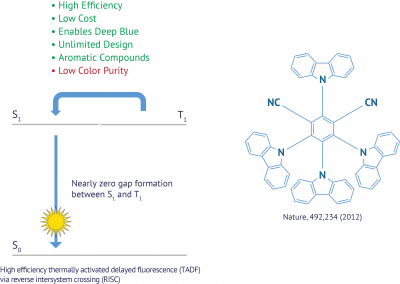TADF, or Thermally activated delayed fluorescence, is a relatievely new type of OLED emissive molecule that may be the key to future OLED displays, as it offers high performance and low cost production.
The emissive layer of an OLED display is its most important layer, where the electric charge is combined with the organic materials and light is emitted. The emissive layer is composed of an emitter and a host, and is the subject of intensive research and development efforts.
TADF emitters set out to solve three main challenges with current generation OLED emitters:
Low cost and non-heavy-metal alternative to current red and green phosphorescent emitters
Efficient and long-lasting soluble emitters suitable for ink-jet printing
An efficient and long-lasting blue emitter
TADF molecules have a small energy gap between the singlet and the triplet energy states (⊿Est). This enables up-conversion of excited energy from triplet to singlet spin, which provides highly efficient photonic emission from the singlet energy state in the form of delayed fluorescence.

TADF was pioneered by Kyushu University’s Prof. Adachi and his world-renowned Organic Photonics and Electronics Research center (OPERA). TADF research began in 2009, and in recent years there is an extensive R&D effort by academics and enterprises all over the world.
In 2019 the first commercial Hyperfluprescence™ OLED display was announced – Wisechip’s 2.7″ yellow PMOLED, powered by Kyulux’s TADF/Hyperfluorescence™ technology.
TADF materials enable efficient (up to 100% IQE) and long lasting displays, but TADF emission also suffers from a relatively wide emission spectrum – which limits the color gamut of the OLED display. Kyulux’s Hyperfluorescence™ emission, considered to be the 4th-generation OLED emission technology, builds up on TADF and combines it with fluorescence emission to create highly efficient, stable and narrow-spectrum emitter systems.



